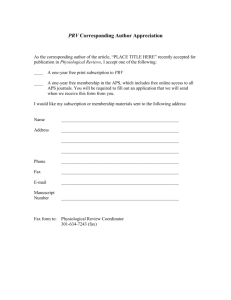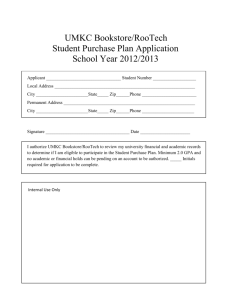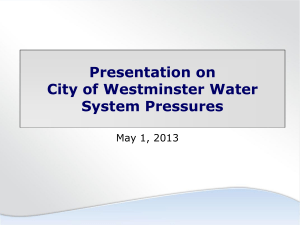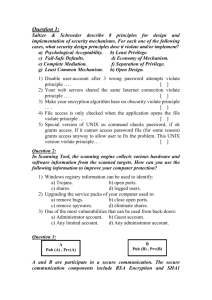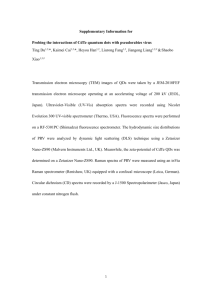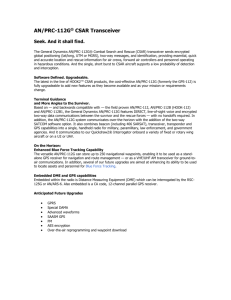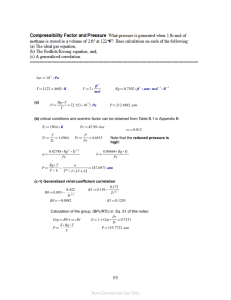FOUO CAPABILITY DEVELOPMENT DOCUMENT FOR COMBAT
advertisement
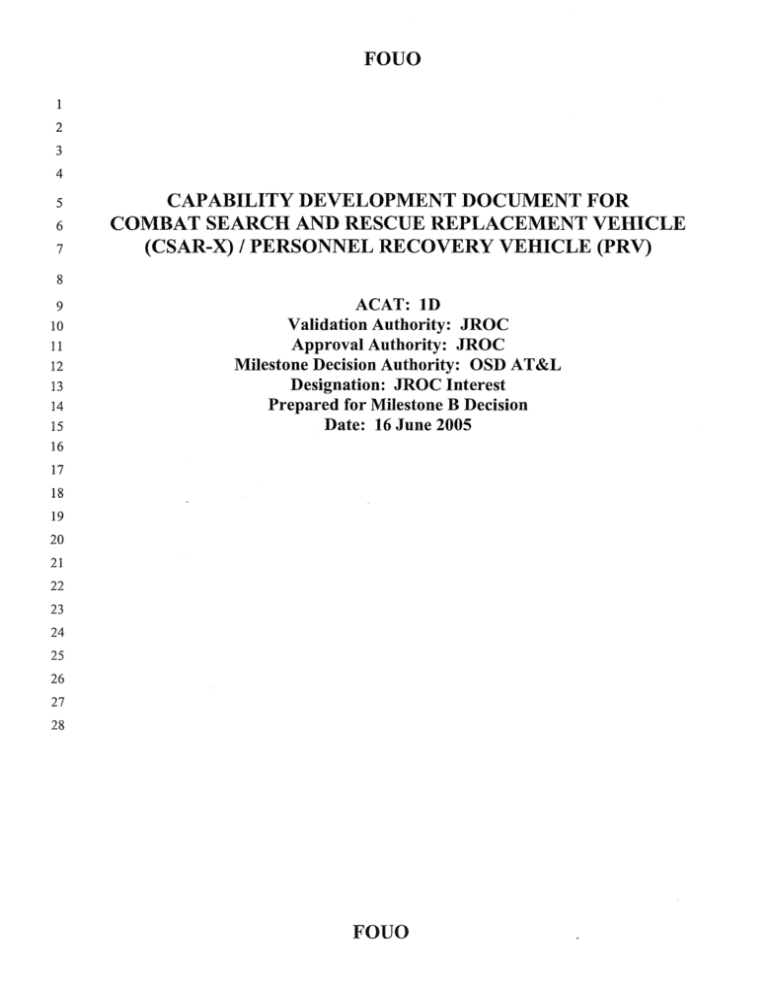
FOUO 1 2 3 4 5 6 7 CAPABILITY DEVELOPMENT DOCUMENT FOR COMBAT SEARCH AND RESCUE REPLACEMENT VEHICLE (CSAR-X) / PERSONNEL RECOVERY VEHICLE (PRV) 8 9 10 11 12 13 14 15 ACAT: 1D Validation Authority: JROC Approval Authority: JROC Milestone Decision Authority: OSD AT&L Designation: JROC Interest Prepared for Milestone B Decision Date: 16 June 2005 16 17 18 19 20 21 22 23 24 25 26 27 28 FOUO FOUO 29 Executive Summary 30 The Combat Search and Rescue Replacement Vehicle (CSAR-X) / Personnel Recovery Vehicle (PRV) is a new 31 acquisition program to replace the HH-60G helicopter for the United States Air Force (USAF) with a new 32 medium-lift aircraft. The primary mission of the CSAR-X (PRV) is Combat Search and Rescue (CSAR). This 33 Capability Development Document (CDD) is based on the Joint Requirements Oversight Council (JROC) 34 validated Operational Requirements Document (ORD) CAF 315-97-B Personnel Recovery Vehicle dated 09 35 Feb 2004. This ORD to CDD conversion was necessary to meet new Joint Staff policies and guidance for 36 requirements development and validation needed to meet an ACAT 1D Milestone B decision in Oct 2005. The 37 current HH-60G does not meet mission requirements. This CDD identifies capabilities to satisfy capability 38 shortfalls experienced in the current HH-60G in support of CSAR mission tasking. 39 Air Combat Command (ACC) mission area planning generated a Combat Air Forces Mission Needs Statement 40 (CAF MNS 315-97) validated by JROCM 005-99, 13 Jan 99. The MNS 315-97 highlighted HH-60G capability 41 shortfalls in service life, flight characteristics, survivability, responsiveness, cabin space, adverse weather 42 capability, mission equipment, hoist, NVG compatibility, avionics human factors, and C4ISR interoperability. 43 A Combat Rescue Analysis of Alternatives (CR AoA) was subsequently conducted that included requirements 44 analysis, system concept studies, operational effectiveness, cost, cost-effectiveness, and sensitivity analyses. 45 Using three Defense Planning Guidance (DPG) scenarios, the evaluation criteria included eight Measures of 46 Effectiveness (MoE): Deployment Time, Deployment Footprint, Aircrew Rescued, Rescue Time, Survivability, 47 Supporting Assets, Terminal Area & Payload, and Supportability. Each candidate concept was evaluated 48 against these criteria and an acquisition risk assessment was performed. The CR AoA recommended the 49 acquisition of 132 medium lift helicopters as the optimal solution with an Initial Operational Capability (IOC) 50 of 2010. An update to the AoA was conducted to address changes to the original AoA. The finding of the 51 update confirmed the findings of the original AoA however the size of the force structure was increased to 141 52 production aircraft to conform to the Strategic Planning Guidance. 53 The CSAR-X (PRV) has 9 unique Key Performance Parameters (KPPs) essential to execution of the CSAR 54 mission: Combat Radius, Rotor Downwash, Net Ready, Deployability, Self Defense, Survivability Electro55 Optic/Infrared, Radio Frequency Threat Countermeasures, and Payload and Cabin Space. The Net-Ready KPP 56 will support interoperability within the Net-Centric information environment and addresses the requirements of 57 the Combat Identification (CID); Global Air Traffic Management (GATM), Global Information Grid (GIG), 58 Cryptographic Modernization Mission (CM) and Close Air Support (CAS) Mission Area Initial Capability 59 Documents (MA ICD). In the ORD to CDD conversion process the High Performance Team (HPT) promoted 6 60 attributes to Key System Attributes (KSAs). The KSAs include: Hover Performance, Airspeed, Tactical 61 Navigation and Adverse Weather, Aerial Refueling, Availability; and Readiness and sub-bullets from the Self 62 Defense KPP. The KPPs remain the same from the JROC approved PRV ORD. The 6 KSAs consist of requirements from the original ORD. 63 64 The primary mission of the CSAR-X (PRV) is to recover isolated personnel (IP) from hostile or denied 65 territory. As such, the CSAR-X (PRV) is a "critical asset" with operations that are integrated in accordance 66 with (IAW) the seven USAF Concepts of Operations (CONOPS). The CONOPS specifically address the USAF 67 unique capabilities that support Joint Functional Capability requirement of Force Application and Force Protection across the full spectrum of political and military operations in all environments. 68 69 70 71 72 73 74 75 The CSAR-X (PRV) will be a dual-piloted, multi-engine, vertical takeoff and landing platform that will bring the latest vertical lift and command and control communications technology to meet CSAR mission requirements. The platform shall be capable of employment day or night, in adverse weather, and in a variety of threat spectrums from terrorist attacks to Chemical, Biological, Radiological, and Nuclear (CBRN) threats. The platform shall be designed as a safe, reliable, available, and maintainable platform. Additionally, the system shall have enhanced survivability capabilities for the recovery of personnel from denied territories. Joint interoperability, compatibility, and connectivity with Joint Force command and control infrastructure and FOUO ii FOUO 76 77 78 79 80 81 supporting agencies and assets are essential to the execution of the mission. The platform will address all command, control, communications, computer and intelligence (C4I) requirements and other standardization considerations. C4I systems acquired under this CDD will comply with all applicable GIG MA-ICD and NRKPP requirements. All electromagnetic effects on, of, and between the CSAR-X (PRV) aircraft, its equipment, supporting systems, and operations environment shall be mitigated, minimized, or countered, to avoid mission degradation. 82 As a result of the Global War on Terrorism, Air Force Special Operations Command (AFSOC) has determined 83 that the required IOC is 2010. Full Operational Capability (FOC) is defined when all HH-60Gs have been 84 replaced with 141 production PRV aircraft. The CSAR-X (PRV) will use an evolutionary strategy employing a 85 block upgrade approach to achieve the full required capability. AFSOC will program for replacement aircraft 86 beginning in FY05. A budgetary planning estimate for the CSAR-X (PRV) is $12B with an estimated unit cost of 87 $50M. 88 To define the required CSAR-X (PRV) training components, Air Education and Training Command (AETC), in 89 conjunction with AFSOC, will conduct a formal Training System Requirements Analysis (TSRA) to determine 90 the training capabilities, numbers, and locations of all required aircrew, intelligence, and maintenance training 91 devices. The TSRA must be completed in time to support required Aircrew, Intelligence, and Maintenance 92 Training Device and development/procurement activities. All training device functions and performance must be 93 consistent with the CSAR-X (PRV) requirements to provide the most efficient and effective training possible. 94 95 96 97 98 99 100 101 102 103 104 105 106 107 Revision History 108 109 The CSAR-X (PRV) CDD is a JROC approved (Feb 2004) ORD to CDD effort. There are no previous 110 versions 111 112 113 114 FOUO iii FOUO 115 FOUO iv FOUO 116 Table of CSAR-X (PRV) CDD Appendices 117 118 Appendix A: Mission Area Initial Capability Document Crosswalks 119 Appendix B: Integrated Architecture Products 120 Appendix C: References (AV-1) 121 Appendix D: Acronym List (AV-2) 122 Appendix E: Requirements Correlation Table 123 Appendix F: Threat Warning and Countermeasures Requirements 124 Appendix G: Mission Scenarios and SCLs 125 Appendix H: CSAR-X (PRV) Supporting Documentation Points of Contact 126 127 Lt Col David McCombs, David.McCombs@hurlburt.af.mil, AFSOC/XPRV, DSN 579-1693, Comm. 850-884- 128 1693. 129 Maj Gregory M. Meek, Gregory.Meek@hurlburt.af.mil, AFSOC/XPRV, DSN 579-5520 FOUO FOUO 169 Table 1-1: Joint Operating Concepts Correlation Table Necessary Capability Major Combat Operations Stability Operations Strategic Deterrence Homeland Security Force Application Yes Yes NA NA Overseas Presence (Forward Regions) NA NA Yes Yes Allied Cooperation NA NA Yes NA Force Projection NA NA Yes NA Global Strike NA NA Yes NA 170 Table 1-2: Joint Functional Concepts Correlation Table Battlespace Awareness Focused Logistics Force Application Command & Control Protection Training NetCentric Force Management No No Yes No Yes No No No 171 172 173 174 Personnel Recovery of isolated personnel is an enabling capability supporting the Joint Force Application Functional Concept as outlined in USAF Master Capability Library Version 5.4. Section 61 defines the required capability attributes to generate CSAR forces capability to conduct the CSAR mission. 175 176 177 The following are shortfalls of the existing system and C4ISR architectures that are summarized in CAF MNS 315-97 (validated by JROC Jan 99), updated in the AFSOC FY04 Personnel Recovery/Recovery Operations (PR/RO), and identified in the CR AoA (approved by AFROC Jun 01). 178 1.1. Existing Capability Gaps. Specific capability shortfalls include: 179 • Service Life. The HH-60G is approaching the end of its useful service life. 180 181 182 • Flight Characteristics. Aircraft and rotor system design limit unrefueled combat radius, mid-mission hover capability, and speed. In certain theaters, these characteristics do not meet Combatant Commanders mission requirements for mission execution or deployment. 183 184 185 186 • Survivability. Insufficient survivability (susceptibility and vulnerability) to ensure mission success against the Defense Planning Guidance (DPG) validated threat environment. This includes a limited electronic warfare suite, insufficient defensive armament for suppression of air and ground threats, and inadequate protection from small arms fire for cabin occupants. 187 188 189 • Responsiveness. Deployment shortfalls that prevent current combat rescue forces from being mission ready upon commencement of hostilities – the most likely time for aircraft losses and the period of highest demand for CSAR missions. 190 191 192 • Cabin Space. Extremely limited cabin space for stowage and employment of mission equipment and crew served weapons, infiltration of Recovery Teams, exfiltration of Recovery Teams and isolated personnel, and medical treatment of isolated personnel. 193 194 • Mission Equipment. Mission and survival equipment adopted from other USAF mission areas not optimized for Personnel Recovery mission. FOUO 2 FOUO 454 455 456 (FOL), shipboard, deliberate planning, time sensitive targeting (TST)). Information needed includes the apportioned tasks, forces assigned and threat information for the theater within which the plan is being developed. 457 458 459 460 461 462 463 464 3.1.2. Train Forces. The training of CSAR Forces includes training for maintenance, operations, intelligence 465 466 467 468 469 470 471 472 and support personnel. Training must include initial qualification training, recurring currency requirements, upgrade training, and specialized (altitude chamber, NBC, Intelligence Formal Training Unit, etc) ground training. CSAR training events must include integration and immersion training with Command, Control, Communications, Computer, Intelligence, Surveillance, and Reconnaissance (C4ISR) organizations and functions, and integration into major force employment through major exercise training. It pre-supposes availability of appropriate training systems, simulators, and courses of instructions to ensure expertise in execution of operational and sustainment/support tasks. 3.1.3. Deploy/Re-deploy Forces. CSAR is among the most time-sensitive operations. Recovery forces must be prepared for rapid deployment to meet Joint Force Commander (JFC) tasking. Dependent on recovery force tasking, CAF planners must ensure recovery forces are [within theater] prior to or at the start of hostilities. Deployment includes the immediate preparations, deployment by airlift or self-deployment depending on recovery vehicle capability and deployment range, and re-deployment of units to and from main operating base (MOB) and FOL (deployment intra-theater to support FOL operations), and US Navy air-capable ships. Factors include time to tear-down/build-up aircraft (if required), time to mission ready, deployment footprint, C4ISR reach back from FOL, and logistics support. 3.1.4. Develop Mission Plans. CSAR forces proactively and collaboratively accomplish mission planning 473 474 475 476 477 478 479 480 481 tasks to execute missions based on theater OPLAN and CONPLAN. Effective pre-mission planning is essential due to the unpredictability associated with CSAR operations. Pre-mission planning permits CSAR forces to anticipate multiple responses to common scenarios, significantly reducing response times. Planning requirements include, but are not limited to, weather, threats, mission status (ground versus airborne alert), staging/basing, assigned/tasked forces and capabilities, route of flight (pre-planned waypoints/spider routes), communications plan, decision matrix for go/no-go, TST procedures, insertion/extraction procedures, and roles and responsibilities of force protection assets. CSAR operations are subject to operational risk assessment and threat analysis in the same manner as other operations. 482 483 484 485 486 487 488 An isolation event is typically located by either a wing man or intelligence and reconnaissance assets and passed to the Rescue Coordination Center (RCC). The RCC reviews the available information to select and tailor the mission plan and tasks needed forces (On-Scene Commander (OSC), Airborne Mission Commander (AMC), Rescue Escort (RESCORT), Rescue Combat Air Patrol (RESCAP), Suppression of Enemy Air Defenses (SEAD), rescue vehicle, pararescue forces, and tankers). A voice or chat instant message warning may be sent to the alert rescue vehicle during the time the mission plan is under development to reduce their response time. A 9-line message is sent to employ the force. 489 490 3.1.5. Employ. Employment includes mission launch, ingress to the terminal area, terminal area operations, and egress. Specific sub-tasks include: 491 492 493 494 495 496 497 • Initiate/Launch Mission. Addresses the methods, timing, and technology to generate and disseminate a launch order. Characteristics are timeliness, coordination, clarity, contingency tolerance, and inclusiveness of all necessary forces. This function considers action by Surface-based C4ISR (SBC4ISR), Airborne C4ISR (ABC4ISR), and Recovery Forces. This sub-task presumes that isolated personnel are detected in the battlespace and located/identified/authenticated sufficiently to initiate the phase of the mission being conducted. To reduce the time an enemy has to react and possibly thwart a recovery operation, the CSARX (PRV) will employ airborne alert postures and/or improve their position in the battlespace. 498 499 • Ingress to the terminal area. Addresses the flight from the staging point (orbit, FOL, or airfield) to the terminal area and typically executed using the two-ship Recovery Vehicle element, but may be flown FOUO 12 FOUO 1036 responsibilities show that these minimum requirements are needed to prepare and conduct effective CSAR 1037 mission. This requirement is applicable in the enroute and terminal area phases of the mission. CID ICD KPPs, 1038 Identification Criteria, Operational Capability, General CID Family of Systems (FoS), and Other 1039 Interoperability Requirements are listed in Appendix B. Tactical datalinks are systems that exchange 1040 information with other participating aircraft and ground forces according to preset message formats and update 1041 rates. During experiments conducted by the USN and USAF, a properly integrated/implemented CSAR a 1042 tactical datalink has shown a dramatic improvement in: locating and identifying Isolated Personnel; threat 1043 avoidance/disengagement/suppression effectiveness; communications effectiveness clearing the limited voice 1044 channels to only critical transmissions; and CSARTF player Situational Awareness and Workload. When 1045 combined all these improvements serve to increase the speed of the rescue mission by reducing the Vietnam era 1046 C2 delays and increase mission success. The CSAF envisions machine-to-machine (M2M) communications 1047 between platforms, manned and unmanned, on the ground, and in the air to move the USAF toward Joint Vision 1048 2020 (JV2020). 1049 1050 1051 1052 1053 6.4. Deployability (KPP): The CSAR-X (PRV) must be capable of supporting worldwide operations (4000 nm) within 24 hours of departing home station. The aircraft must be configurable for deployment (selfdeployment or USAF C-5 or C-17)(T) within 3 hours and be flight ready within 3 hours of arrival at destination (T); (self-deployment or USAF C-5 and C-17)(0) within 2 hours and be flight ready within 2 hours of arrival at destination (0). (KPP) 1054 1055 If the CSAR-X (PRV) meets the deployability KPP by strategic airlift it still must be capable of 2000 nm selfdeployment with or without aerial refueling support; in 24 hours with less than a 5 percent abort rate (T=0). 1056 To support a 14 day Task Force Operation, the CSAR-X (PRV) system (3 aircraft and deployment package to 1057 include: support equipment, spares/consumables, and weapons) must be capable of being deployed on 2 C-5's 1058 or 3 C-17's (T=0). Support equipment to sustain operations will not exceed 8 pallet positions (T); 4 pallet 1059 positions (0) in support of a 50 hour per month UTE rate. 1060 1061 CSAR-X (PRV) support equipment shall be capable of being transported by commercial and military truck and by USAF AMC Cargo aircraft to include the C-130, C-17, and C-5 (T=0). 1062 1063 1064 1065 1066 1067 1068 1069 Rationale: Transportability requirements listed above shall be in accordance with the appropriate sections of MIL-STD-1366D. The key tenant of Air Force Global Strike and Global Persistent Attack CONOPs is to execute the assigned mission anywhere in the world within 24 hours of tasking. The CSAR-X (PRV) must be capable of supporting these operations by accompanying Global Strike Forces or pre-positioning in support of Global Strike Operations. Key to this capability is the CSAR-X (PRV) rapid deployment capability. Showing up late leaves strike forces without a Personnel Recovery option and increases the risk that a single downing event will deleteriously impact operational objectives as a result of political pressures. A 4000 nm deployment range is required for global coverage based on current locations of CSAR assets. 1070 1071 1072 1073 1074 1075 6.5. Self Defense (KPP). The CSAR-X (PRV) RESCORT will consist primarily of fighters such as the F-16, F-15E, F/A-18, A-10, AV-8, F/A-22 and F-35. The capabilities, limitations, and vulnerabilities of these likely RESCORTs are drivers in CSAR weapon needs. The Joint Munitions Effectiveness Manual (JMEM) definitions for kill levels are used throughout this section. Consideration must be given to using multipurpose weapons. Additionally, to provide mission flexibility, the CSAR-X (PRV) must provide power provisions for alternate weapons (i.e. GAU-2, etc). 1076 1077 1078 1079 1080 1081 1082 ® Force Protection KPP: The CSAR-X (PRV) must be capable of inflicting a 50% (T); 70% (0); probability of incapacitation (30 second assault criteria) on a grouped 8 man enemy element in the open (i.e., not dug in) out to 1000m (T); 1500m (0)(KPP). This suppression level must be achieved within 5 seconds after first round on target. Suppression capability must be available in all quadrants (T); 360 degree coverage (0) against infantry around the CSAR-X (PRV) with elevation coverage from plus 2 to minus 75 degrees from the aircraft waterline (T); +5 to – 90 degrees elevation coverage is desired (0)(KSA). The sequence from threat detection to putting ordnance on infantry targets should not exceed 3 FOUO 36
